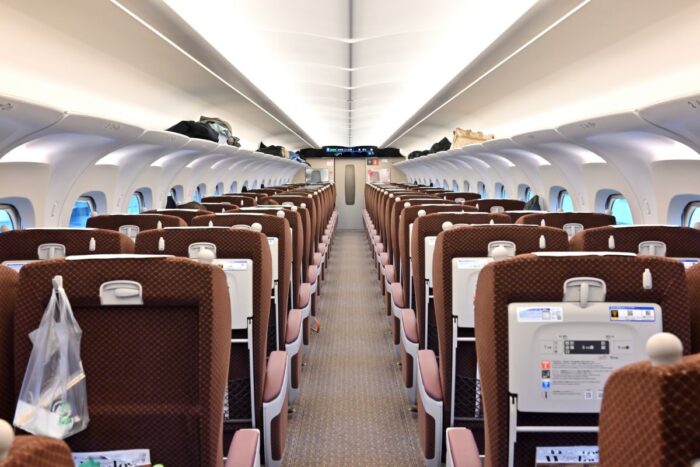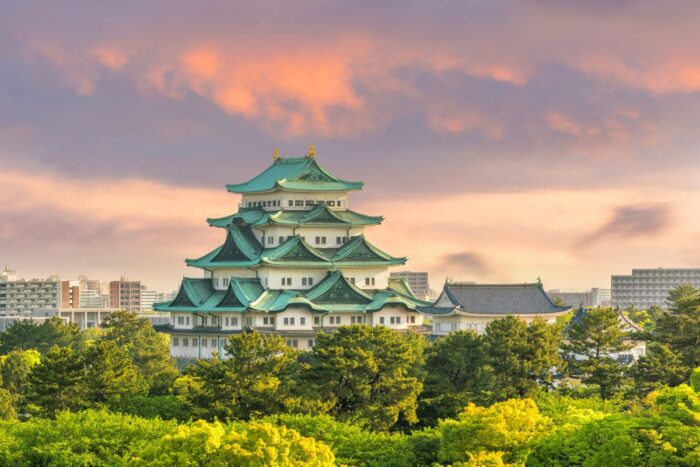Nagoya, a once underappreciated stopover between Tokyo and Kyoto, is fast becoming a destination in its own right. Thanks to the autumn 2022 opening of the anticipated Ghibli Park, Nagoya is now a hotspot for locals and tourists alike.
Strategically nestled about 340 kilometers west of Tokyo, Nagoya serves as the dynamic capital of the Aichi Prefecture. Besides being the fourth most populous urban area in Japan, the city is now known for its burgeoning tourism scene.
Travel from Japan’s bustling capital to its heartland with this comprehensive guide for travel from Tokyo to Nagoya.
We explore various transportation methods, including trains, planes, and buses. However, if speed is your top priority, we highly recommend the exceptional Shinkansen bullet train system.
How Much Does it Cost To Travel From Tokyo to Nagoya?

While Japan is renowned for its stunning beauty, travel costs can sometimes be a deterrent. Notably, the Japan Rail Group announced a price increase for their popular JR Pass product on April 14th. As of October 1st, the cost of a standard seven-day pass is projected to rise from ¥29,000+ to approximately ¥50,000.
Taking this into consideration, driving from Tokyo to Nagoya might seem cost-effective, especially if you’re up for splitting highway tolls among a group. However, for solo travelers or small groups, this might not be the most economically friendly option.
Instead, the train offers a reliable alternative. It delivers better value for money, regardless of the size of your traveling party. This section will explore the different train options, their pros, cons, costs, and what to expect during your journey.
Tokyo To Nagoya By Shinkansen

For those prioritizing convenience and speed, the Shinkansen, or the bullet train, is a perfect choice. The Shinkansen’s route extends directly from city center to city center, providing a smooth journey devoid of needless detours or transfers. In Tokyo, there are two stations to catch this high-speed mode of transportation: Tokyo Station and Shinagawa Station.
Arrival and Duration
Upon disembarking at Nagoya, you’ll find yourself at the city’s main train station. It’s a central location and an excellent starting point to explore everything Nagoya has to offer.
The duration of the trip depends on the type of Shinkansen service you choose. On average, the journey lasts between 100 and 120 minutes. The Nozomi service, the fastest of the Tōkaidō Shinkansen options, completes the journey in just over an hour and forty minutes. The Hikari service is a bit slower, often exceeding the two-hour mark. If you plan to use the Japan Rail Pass, you might need to adjust your schedule to travel via the Kodama service, which is more leisurely.
When choosing your service, consider the balance between cost and convenience. Our professional recommendation is to invest in expedited services like Hikari or Nozomi, unless you are on a tight budget.
Shinkansen Ticket Costs
In the peak seasons, such as the spring and summer holidays and Golden Week over New Year’s, a regular one-way ticket will cost you approximately ¥11,300. If you’re traveling during off-peak times, the rates drop slightly. Non-reserved seating, known locally as jiyūseki, offers a potential saving of about ¥700. Still, be prepared for the possibility of standing throughout your journey, especially during high-traffic seasons.
Luggage Rules and Recommendations

Traveling with large suitcases? Consider using a luggage delivery service. If you choose to bring your luggage onto the Shinkansen, note that specific regulations apply. If your luggage dimensions total between 160cm and 250cm, you’ll need to make special reservations (included with your JR pass). For items under 160cm, overhead racks are available, provided there’s sufficient space.
Traveling with Japan Rail Pass
If you’re planning to do a lot of traveling within Japan during a short period, the Japan Rail Pass offers a cost-saving method. Priced at ¥29,110 for a seven-day interval, the pass covers your travel on all JR trains across the country, potentially providing significant savings compared to buying single return tickets for each trip. This pass is particularly cost-effective if your itinerary includes travel to other destinations along the route, such as Kyoto and Osaka.
Tokyo To Nagoya By Local Trains
For rail enthusiasts, there’s an alternative option. The journey from Tokyo to Nagoya via JR trains along the Tokaido Main Line offers a leisurely trip that requires time and patience. This route runs parallel to the Tōkaidō Shinkansen but involves multiple stops and transfers, stretching the trip to 6-7 hours.
The cost of a one-way fare is typically ¥6,380, but a cost-efficient option exists in the form of the Seishun 18 Ticket. This pass gives you five non-consecutive days of unlimited local or rapid JR train rides. Although it’s not for those in a hurry, it offers an excellent way to see the country at your own pace for a reasonable cost of just ¥12,050 per ticket.
Flights From Tokyo To Nagoya

Those on a tight budget but looking to save time might consider catching a flight from Tokyo to Nagoya. Japan’s low-cost carriers offer prices as low as ¥4,000 for the one-hour flight. Be aware, though, that these budget flights typically depart from Narita Airport, not the more centrally located Haneda Airport.
There are discounts available through JAL or ANA for foreign travelers on inbound flights into Chubu Airport Nagoya via Haneda. Remember to keep an eye out for these deals while planning your trip.
After considering all the financial and logistical aspects, flying from Tokyo to Nagoya may not be the best option for most travelers. The time and money saved on the actual flight can quickly be eaten up by airport transfers. Unless you’re traveling from a more distant location, such as Sapporo, the Shinkansen is often the more rational choice.
Highway Buses To Nagoya
The most economical option between Tokyo and Nagoya is the highway bus, with one-way tickets priced at just ¥2,000. This budget-friendly option has a travel time of 6-8 hours, making it a less appealing choice for those traveling with young children or those of taller stature.
However, most buses leave late in the night and arrive at dawn, maximizing your daytime hours for sightseeing without requiring additional hotel bookings. Daytime options are also available through providers like Kosoku Bus or Willer Express.
Please note that “Nagoya” may sometimes be listed under its larger administrative area, “Aichi,” in online searches. Also, remember to compare pricing across all transit modes since some services may end up being surprisingly more expensive than the bullet train fares.
Be Prepared for Changes
It’s important to bear in mind that Japan, like any country, is subject to changes in infrastructure and pricing. The introduction of the Ghibli Park in Nagoya and the announced price increase for the popular JR Pass are examples of recent changes that have impacted travel within the country.
Therefore, always double-check the most up-to-date information before you plan your travel. Websites like Hyperdia and Jorudan, along with the official pages of various transportation services, are invaluable resources for confirming current ticket prices, timetables, and more.
Make the Most of Your Journey

Whether your travel style is fast and efficient or leisurely and scenic, the journey from Tokyo to Nagoya is not merely a necessary transit but an integral part of your Japanese adventure. Look out the window, watch the changing landscapes, engage with fellow travelers, and immerse yourself in the rich tapestry of Japanese culture and tradition.
Ultimately, the journey from Tokyo to Nagoya, no matter how you choose to undertake it, is an adventure in and of itself. Plan wisely, travel safely, and above all, enjoy every moment of your trip. As the Japanese proverb goes, “Even a road of a thousand miles begins with a single step”. Your adventure is waiting.
Where To Stay In Tokyo
Tokyo visitor levels are currently at an all-time high so make sure to book your hotels early. Tip most hotels booked with booking.com have free cancelation so book as soon as you know your date and you can always cancel if you change your mind.



